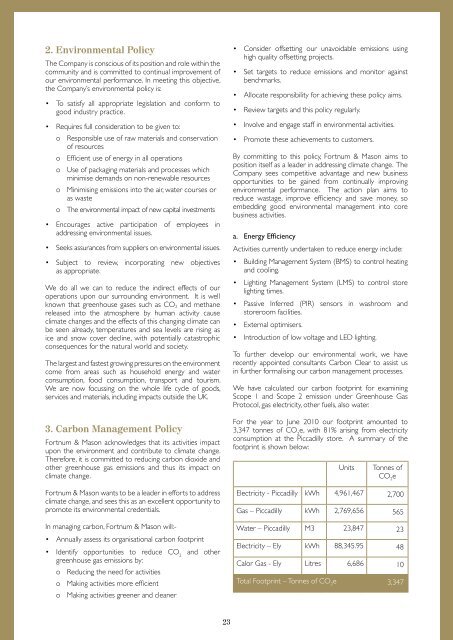You also want an ePaper? Increase the reach of your titles
YUMPU automatically turns print PDFs into web optimized ePapers that Google loves.
2. Environmental Policy<br />
The Company is conscious of its position and role within the<br />
community and is committed to continual improvement of<br />
our environmental performance. In meeting this objective,<br />
the Company’s environmental policy is:<br />
• To satisfy all appropriate legislation and conform to<br />
good industry practice.<br />
• Requires full consideration to be given to:<br />
o Responsible use of raw materials and conservation<br />
of resources<br />
o Efficient use of energy in all operations<br />
o Use of packaging materials and processes which<br />
minimise demands on non-renewable resources<br />
o Minimising emissions into the air, water courses or<br />
as waste<br />
o The environmental impact of new capital investments<br />
• Encourages active participation of employees in<br />
addressing environmental issues.<br />
• Seeks assurances from suppliers on environmental issues.<br />
• Subject to review, incorporating new objectives<br />
as appropriate.<br />
We do all we can to reduce the indirect effects of our<br />
operations upon our surrounding environment. It is well<br />
known that greenhouse gases such as CO2 and methane<br />
released into the atmosphere by human activity cause<br />
climate changes and the effects of this changing climate can<br />
be seen already, temperatures and sea levels are rising as<br />
ice and snow cover decline, with potentially catastrophic<br />
consequences for the natural world and society.<br />
The largest and fastest growing pressures on the environment<br />
come from areas such as household energy and water<br />
consumption, food consumption, transport and tourism.<br />
We are now focussing on the whole life cycle of goods,<br />
services and materials, including impacts outside the UK.<br />
3. Carbon Management Policy<br />
Fortnum & Mason acknowledges that its activities impact<br />
upon the environment and contribute to climate change.<br />
Therefore, it is committed to reducing carbon dioxide and<br />
other greenhouse gas emissions and thus its impact on<br />
climate change.<br />
Fortnum & Mason wants to be a leader in efforts to address<br />
climate change, and sees this as an excellent opportunity to<br />
promote its environmental credentials.<br />
In managing carbon, Fortnum & Mason will:-<br />
• Annually assess its organisational carbon footprint<br />
• Identify opportunities to reduce CO and other<br />
2<br />
greenhouse gas emissions by:<br />
o Reducing the need for activities<br />
o Making activities more efficient<br />
o Making activities greener and cleaner<br />
23<br />
• Consider offsetting our unavoidable emissions using<br />
high quality offsetting projects.<br />
• Set targets to reduce emissions and monitor against<br />
benchmarks.<br />
• Allocate responsibility for achieving these policy aims.<br />
• Review targets and this policy regularly.<br />
• Involve and engage staff in environmental activities.<br />
• Promote these achievements to customers.<br />
By committing to this policy, Fortnum & Mason aims to<br />
position itself as a leader in addressing climate change. The<br />
Company sees competitive advantage and new business<br />
opportunities to be gained from continually improving<br />
environmental performance. The action plan aims to<br />
reduce wastage, improve efficiency and save money, so<br />
embedding good environmental management into core<br />
business activities.<br />
a. Energy Efficiency<br />
Activities currently undertaken to reduce energy include:<br />
• Building Management System (BMS) to control heating<br />
and cooling.<br />
• Lighting Management System (LMS) to control store<br />
lighting times.<br />
• Passive Inferred (PIR) sensors in washroom and<br />
•<br />
storeroom facilities.<br />
External optimisers.<br />
• Introduction of low voltage and LED lighting.<br />
To further develop our environmental work, we have<br />
recently appointed consultants Carbon Clear to assist us<br />
in further formalising our carbon management processes.<br />
We have calculated our carbon footprint for examining<br />
Scope 1 and Scope 2 emission under Greenhouse Gas<br />
Protocol, gas electricity, other fuels, also water.<br />
For the year to June 2010 our footprint amounted to<br />
3,347 tonnes of CO 2 e, with 81% arising from electricity<br />
consumption at the Piccadilly store. A summary of the<br />
footprint is shown below:<br />
Units Tonnes of<br />
CO 2e<br />
Electricity - Piccadilly kWh 4,961,467 2,700<br />
Gas – Piccadilly kWh 2,769,656 565<br />
Water – Piccadilly M3 23,847 23<br />
Electricity – Ely kWh 88,345.95 48<br />
Calor Gas - Ely Litres 6,686 10<br />
Total Footprint – Tonnes of CO 2e 3,347


